 Menu
Menu
|
Function To study the angle of rotation of an optically active solution. |
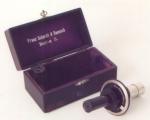
| ||
|
|||
|
Description It is formed by a Nicol prism, a circular vernier and an eyepiece. | |||
|
Function To study the angle of rotation of an optically active solution. |
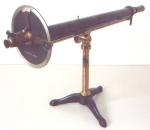
| ||
|
|||
|
Description The light beam, generated by a monochromatic source (sodium light), crosses the Nicol prism (polarizer). The light that comes out is linearly polarized and half of it goes directly to the analyzing solution while the other half first crosses a half-wave plate. The two beams, with two different planes of polarization, are then analyzed by another Nicol prism. A circular vernier is placed on the eyepiece. By rotating the analyzer the intensity of the two beams changes. We have two angles where the two half zones are weakly or strongly illuminated, but with the same intensity. | |||
|
Function To study the light polarisation. |

| ||
|
|||
|
Description It is made of a mirror placed on the basis, an inclinable crystal plate (polariser) with a device to read the angle, a mobile object holder formed by a ring that encloses a glass disk and an analyser (black mirror). The light emitted by the source passes across the polariser and therefore goes towards the black mirror. A different path can be: source, polariser, mirror on the basis, polariser, black mirror. | |||
|
Function |
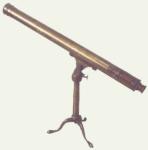
| ||
|
|||
|
Description The apparatus is made of a brass tube at the end of which we have the objective and the eyepiece. The tube is tied with a hinge to a pole that stand on a tripod. The objective is formed by a converging lens with a great focal distance and for this it produces an inverted, reduced and real image. If this image is formed at a shorter distance from the focal distance of the eyepiece, we obtain a right-side up, magnified and virtual image. The image is inverted compared to the object. | |||
|
Function Apparatus for projection. |
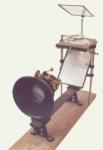
| ||
|
|||
|
Function Schematic model of the eye. |
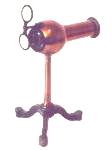
| ||
|
|||
|
Description We have a little camera obscura with an objective and a screen. The ensemble is made of brass and stand on an iron tripod. By changing the distance between the objective and the screen we can obtain the situation of a far-sighted, normal or short-sighted eye. In the case of the far-sighted or short-sighted eye we can obtain a neat image on the screen by placing on of the two additional lenses placed outside of the eye before the objective. | |||
|
Function |
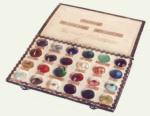
| ||
|
|||